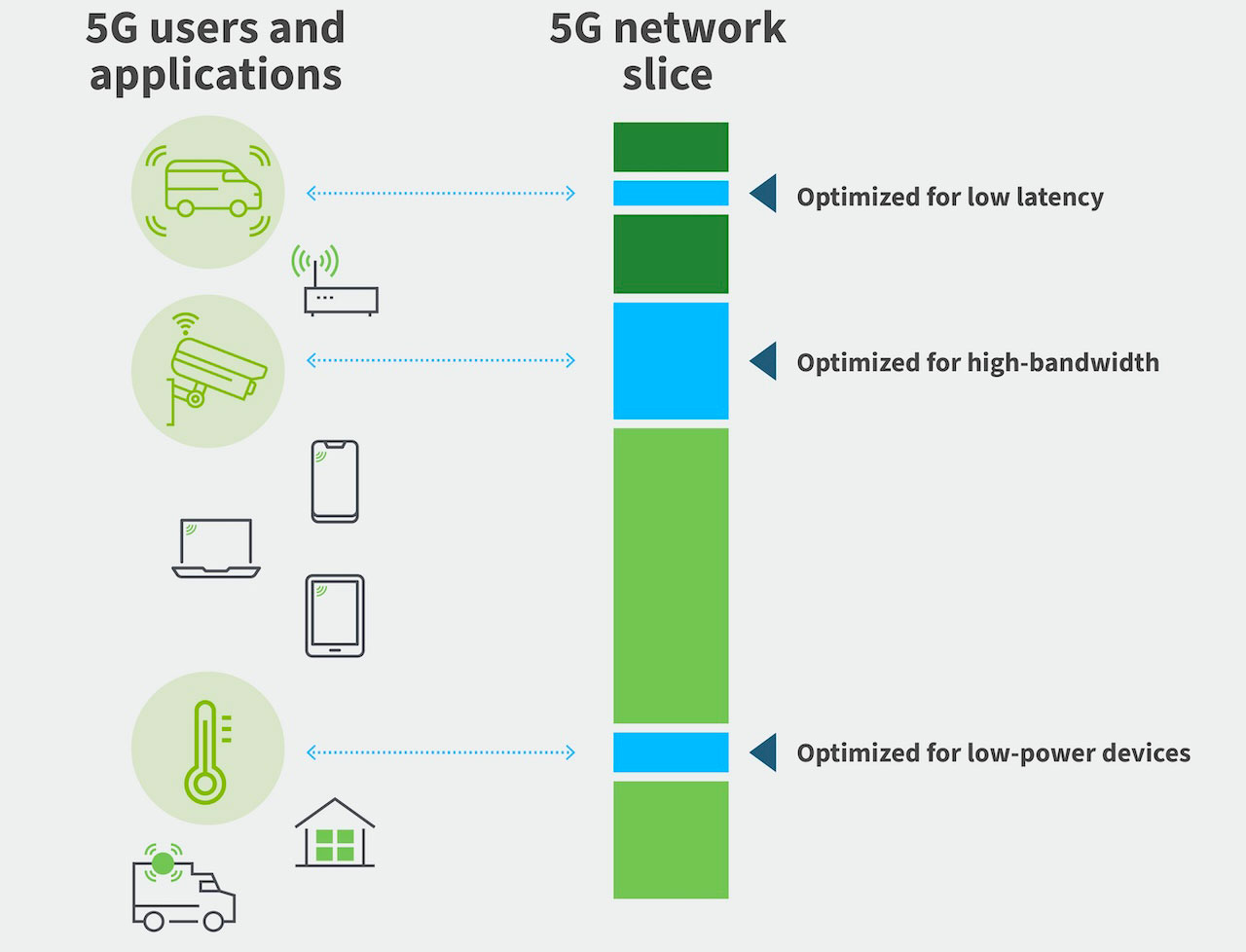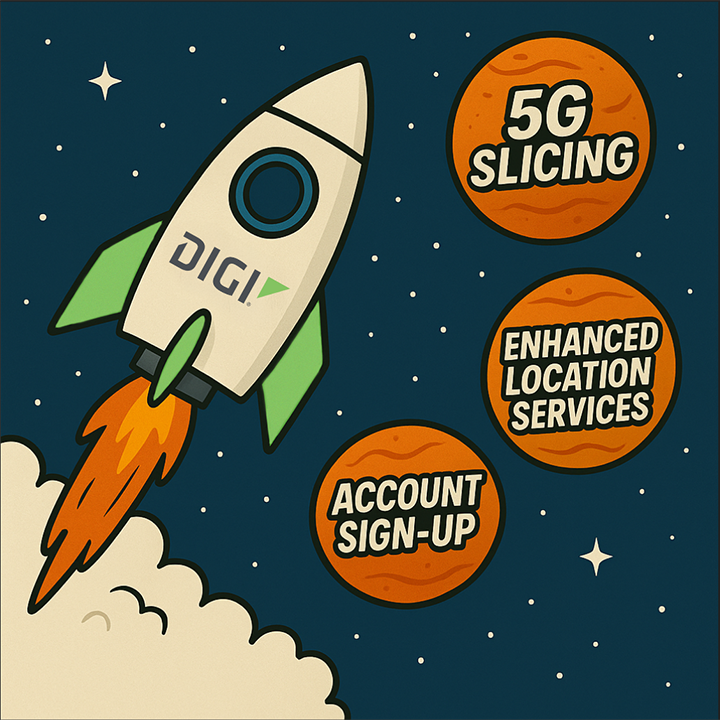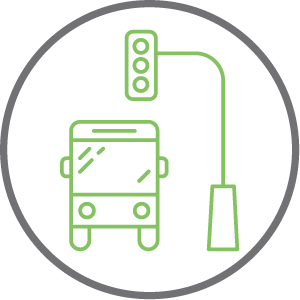As industries move toward increasingly complex and connected ecosystems, network demands continue to grow. From autonomous robots in
Industry 4.0 applications to mission-critical IoT systems like
autonomous vehicles,
V2X and
positive train control in transportation, enterprises need smart, scalable, and flexible connectivity solutions. Digi International’s latest firmware update for
DAL OS routers introduces a groundbreaking capability to meet these needs head-on:
5G network slicing.
This powerful capability creates layers of virtualized networks, allowing different services and users to access network resources with specific requirements. In this way, 5G network slicing technology enables personalized connectivity for diverse use cases, optimizing network resources and improving user experience. Let's dive into a deeper definition of 5G network slicing and its use cases and benefits.
What Is 5G Network Slicing?
 5G network slicing allows carriers to create multiple virtual networks — called slices — on top of a single physical 5G infrastructure. Each slice is optimized for a specific service requirement, whether it's ultra-low latency, high reliability, or massive device density.
5G network slicing allows carriers to create multiple virtual networks — called slices — on top of a single physical 5G infrastructure. Each slice is optimized for a specific service requirement, whether it's ultra-low latency, high reliability, or massive device density.
With Digi’s 5G multi-slicing support, DAL OS routers can now route traffic through multiple cellular network slices simultaneously. This means organizations can separate and prioritize different types of data — like video surveillance, industrial control systems, or POS terminals — without needing multiple SIM cards or complex SD-WAN solutions with VPN overheads.
For example, in a manufacturing automation setting, high-bandwidth HD camera streams can be routed through one slice, while low-latency commands to robotic arms are handled by another. It’s like having dedicated traffic lanes on a digital highway.
Why 5G Network Slicing Matters for Enterprises
Internet of Things technologies and solutions are advancing constantly — but with those advances comes complexity. Digi is committed to supporting organizations in planning and deploying connected systems as seamlessly as possible. Let’s look at how 5G network slicing can improve your operations.
1. Simplified Architecture
Traditionally, separating network traffic types required complex SD-WAN overlays or multiple physical connections. With 5G network slicing architecture, this can now be managed at the carrier level, dramatically simplifying infrastructure while still ensuring critical data gets the right priority.
2. Carrier-Agnostic Flexibility
Digi’s 5G network slicing support is carrier-agnostic, aligning with the global evolution of 5G Standalone (SA) networks. While T-Mobile is currently the most advanced in offering commercial slicing, other carriers like Verizon, AT&T, and Vodafone are catching up. Digi’s routers are built to support slicing wherever it's available.
3. Industrial and Edge Use Cases
This capability is especially impactful in industrial environments and edge computing. From autonomous mobile robots (AMRs) in warehouses to real-time monitoring in oil and gas operations, 5G slicing enables precise traffic management without sacrificing performance.
4. Future-Proofing Deployments
Even if a carrier's slicing implementation is not fully live today, many enterprise customers are planning for 5–10-year hardware cycles. With Digi’s support for 5G SA slicing now in place, deployments are ready for what comes next in cellular technology.
Key Features of Digi’s 5G Network Slicing Integration
 Here are some key features of this integration to support your deployment.
Here are some key features of this integration to support your deployment.
- Multiple slice configuration support: Up to 8 slices per SIM (carrier permitting)
- Customize-able setup: Enables network engineers to assign interfaces to slices and set routing preferences manually
- Slice type and differentiator options: Choose from embedded, low latency, massive IoT, or custom-defined slice types
- Fully integrated with Digi Remote Manager® (Digi RM): Enhanced UI and dashboard tools display active slice connections, helping monitor and manage deployments in real time
- Automatic slice detection: DAL OS routers detect supported slice configurations from the carrier at connection time, allowing for quicker validation and troubleshooting
5G Network Slicing Examples
Let's look at some 5G network slicing examples to highlight some of the current and future use cases for 5G slicing.
Commercial Use Cases
 In commercial applications, 5G network slicing enables businesses to tailor their network infrastructure to meet specific operational needs. For example, retail chains can use dedicated 5G slices to manage their in-store IoT devices, point-of-sale systems, and customer engagement tools with minimal latency.
In commercial applications, 5G network slicing enables businesses to tailor their network infrastructure to meet specific operational needs. For example, retail chains can use dedicated 5G slices to manage their in-store IoT devices, point-of-sale systems, and customer engagement tools with minimal latency.
A slice could be optimized to handle high-bandwidth applications like augmented reality (AR) for enhanced in-store retail experiences or real-time inventory tracking, ensuring that these services run smoothly without interference from other applications. Additionally, enterprises can create secure network slices for sensitive customer data, ensuring privacy and security while optimizing the performance of in-store technologies like smart checkout systems and digital signage.
Industrial Use Cases
 In industrial environments, 5G network slicing can vastly improve operational efficiency and reliability. Manufacturing plants can create dedicated slices for mission-critical applications, such as robotics, real-time monitoring systems, and predictive maintenance tools. These applications require ultra-low latency and high reliability to ensure smooth operations and prevent downtime.
In industrial environments, 5G network slicing can vastly improve operational efficiency and reliability. Manufacturing plants can create dedicated slices for mission-critical applications, such as robotics, real-time monitoring systems, and predictive maintenance tools. These applications require ultra-low latency and high reliability to ensure smooth operations and prevent downtime.
By isolating these functions on a dedicated slice, the risk of network congestion or interference from less critical applications is minimized, ensuring that production lines and machinery operate at peak performance. Additionally, 5G slicing allows Industry 4.0 factories to securely connect to remote maintenance services or supply chain management systems without affecting internal operations, improving both productivity and security.
Transportation Use Cases
 In the transportation industry, 5G network slicing can transform the way vehicles, infrastructure, and systems communicate. For example, in smart cities, traffic management systems can be run on a dedicated 5G slice, enabling real-time updates on traffic flow, signaling, and congestion monitoring.
In the transportation industry, 5G network slicing can transform the way vehicles, infrastructure, and systems communicate. For example, in smart cities, traffic management systems can be run on a dedicated 5G slice, enabling real-time updates on traffic flow, signaling, and congestion monitoring.
Autonomous vehicles can use a separate, highly reliable slice to communicate with each other and with road infrastructure, ensuring low-latency interactions necessary for safe navigation. Additionally, public transportation networks can benefit from dedicated slices for ticketing systems, fleet management, and passenger communications, ensuring reliable service even during peak times or in high-traffic areas. By creating isolated network slices, transportation operators can ensure that critical systems receive the bandwidth and reliability they need while optimizing the overall performance of the transportation network.
How to Get Started
The 5G network slicing capability is part of the DAL OS 25.5 firmware release, available now for select 5G SA-capable Digi router solutions such as the Digi TX64, Digi TX54, and Digi IX40 series. This feature is only available on devices operating on fully 5G Standalone networks.
 To enable slicing:
To enable slicing:
- Use a SIM card that supports 5G slicing (contact your carrier).
- Configure multiple WAN interfaces in the router UI.
- Assign each interface to a slice with appropriate selection types and differentiators.
- Configure policy-based routing rules or quality of service (QoS) settings to control what traffic flows through each slice.
- Monitor slice usage via Digi Remote Manager®.
Learn More
Explore more about 5G slicing and its potential in enterprise and industrial use:
FAQ: 5G Network Slicing and Its Benefits for Industrial and Enterprise Applications

How does 5G network slicing benefit industrial applications?
5G slicing provides industrial applications with dedicated network resources tailored to their needs, such as ultra-low latency, high reliability, and high capacity. By ensuring that industrial IoT devices and critical systems receive the necessary bandwidth and performance, 5G network slicing enables seamless operations in environments like smart factories, connected warehouses, and autonomous machinery. This leads to better real-time monitoring, improved decision-making, and enhanced automation.
What are the key benefits of 5G slicing for enterprise applications?
For enterprises, 5G slicing offers enhanced flexibility, security, and performance. Companies can allocate slices based on specific business needs, such as secure communication for financial transactions or high-bandwidth connectivity for cloud services. By isolating traffic within these slices, enterprises can ensure that their critical data and applications are prioritized without interference from other network traffic. Additionally, it offers scalability, allowing enterprises to adjust their network resources as their business grows.
How does 5G slicing improve reliability in mission-critical operations?
In industries where reliability is paramount, 5G slicing allows for the creation of private, dedicated networks that ensure consistent performance and availability. By reserving specific network resources for mission-critical operations, network slicing 5G technology reduces the risk of network congestion and ensures that latency-sensitive applications, such as remote surgery or autonomous vehicles, can function without disruption. This level of reliability is critical in environments that require continuous, real-time data exchange and decision-making.
Can 5G slicing help with network congestion?
Yes, 5G slicing plays a crucial role in mitigating network congestion. By partitioning the network into multiple slices, each slice can be allocated specific resources such as bandwidth, latency, and capacity based on the demands of the application. This ensures that high-priority traffic, like critical industrial communications or enterprise data, is not affected by less urgent or non-essential network traffic. This efficient allocation of resources helps prevent congestion and enhances the overall performance of the network.
How does 5G slicing support the performance of smart cities and large-scale IoT deployments?
In smart cities and large-scale IoT deployments, network slicing in 5G can create dedicated slices for different services, such as public safety, traffic management, or environmental monitoring. By isolating these services into their own virtual networks, 5G slicing ensures that each service receives the necessary performance and reliability without interference from others. For example, emergency services can have their own slice with priority access, ensuring real-time communication in critical situations, while other applications like smart parking or energy management can operate on separate slices without affecting performance.
What security advantages does 5G slicing offer for industrial and enterprise networks?
5G slicing enhances security by isolating different types of traffic within separate slices. This segmentation helps prevent unauthorized access and minimizes the risk of cyberattacks affecting critical systems. For industrial operations, this means that sensitive data and control signals can be transmitted on a secure, private slice, reducing vulnerabilities from external threats. Similarly, enterprise applications can benefit from the ability to create secure slices for sensitive business operations, ensuring that security breaches in one part of the network do not compromise other services.
How does 5G slicing impact the overall cost of running industrial and enterprise networks?
5G slicing allows for more efficient network management by optimizing resource allocation based on specific application needs. By ensuring that network resources are used more effectively, businesses can reduce the overall cost of network infrastructure while maintaining high performance. Additionally, 5G slicing enables enterprises and industrial applications to scale their network capacity dynamically, only paying for the resources they need at any given time. This reduces waste and helps lower operational costs, especially for businesses with fluctuating or growing network demands.
Final Thoughts
Digi’s integration of 5G multi-slicing into DAL OS marks a significant step forward in delivering carrier-integrated, intelligent routing solutions for the most demanding enterprise and industrial environments. As 5G technology matures, these capabilities will become foundational for everything from smart cities to advanced logistics.
Stay tuned for upcoming tutorials, configuration walkthroughs, and case studies as more customers begin leveraging this powerful new feature.
Next Steps